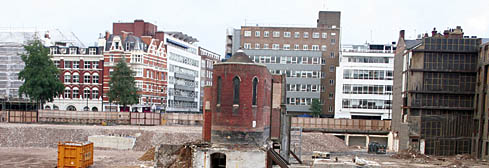|
|
 |
| |

The listed chapel still stands on the site of the former Middlesex Hospital |
How credit crunch spat out ‘Noho’
Leaked report reveals huge loss in value of former hospital site developers walked away from
THERE is a monument to the credit crunch in the heart of Fitzrovia.
Where a world-class teaching hospital once stood, a lonely listed chapel remains in three acres of razed wasteland, cleared to build luxury flats for a generation of financiers now vanished, owned by a bankrupt bank, and abandoned by London’s most aggressive property developers.
The construction machines in “Noho Square”, as the former Middlesex Hospital site was dubbed in more optimistic days, stopped in October last year at the same time as the financial good times for then developers Candy and Candy and Icelandic bank Kaupthing.
But a confidential financial report handed to the Wikileaks website this week claims how entwined the former hospital had become with the global banking crisis – and how property valued at the height of the boom could lose £300million in six months. The site was bought in 2006 from the Middlesex Hospital’s heirs, University College Hospital, for £175m by Project Abbey, a “special-purpose vehicle’” registered in Guernsey and owned by the Candy brothers and Kaupthing.
The report discloses that in November 2007, after the Candys had won blessings from Camden and Westminster councils for 237 high-end flats, the estate agents Savills valued the site at £355m.
By September 2008, based on this valuation, Kaupthing had lent Project Abbey £256.7m, which, added to its own equity meant a £312m stake. When the bank tried to sell the site this spring, market reports put its value at £53m – a drop of £300m.
The bank’s report, dated September last year, notes: “Relationship with Candys has become strained as downturn has impacted their business model. They build for the uber-rich but sales are slowing.” Four weeks later, as the New Journal’s sister paper the West End Extra revealed, the Candy brothers had walked away from the Noho Square deal, and Kaupthing had been nationalised by the Icelandic government.
The deals, in which Kaupthing, legally, levered up £312m of finance for a project in which it was itself a shareholder and which lost 85 per cent of its value almost overnight, took place in what Max Neufeld, chairman of the Charlotte Street Association and an expert on development in Fitzrovia, calls a “totally artificial market atmosphere”.
“The scheme was just too big, an overdevelopment, and Westminster were panicked into giving their permission because of the atmosphere of the time,” he said.
Mr Neufeld is calling for a more realistic development mixing shops and flats on the site, with an “appropriate amount of affordable housing”, and a temporary park while property developers lick their economic wounds and the market recovers.
“We won’t get it because they (builders) always pretend they might start work tomorrow – which we all know is rubbish,” he added.
There is still deep uncertainty over the future of Noho – renamed “No Hope Square” when the crunch bit.
Kaupthing are thought to have sought interest from builders Stanhope Plc, among others, and last week the University of the Arts confirmed that it was one of several sites under consideration for a relocated London College of Fashion.
In Fitzrovia, rumours are circulating that it will become a hotel, one of the least-favoured outcomes among residents. Until then, behind its head-high fences, the site remains a reminder of the vanity of boom, and the reality of bust. |
 |
|
|
 |
| |
| |
|
 |
|